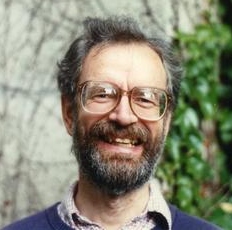Andrew Casson facts for kids
Quick facts for kids
Andrew Casson
|
|
|---|---|

Andrew Casson at Berkeley in 1991
Photo courtesy George M. Bergman |
|
| Born | 1943 (age 81–82) |
| Alma mater | University of Liverpool |
| Awards | Oswald Veblen Prize in Geometry (1991) Fellow of the Royal Society (1998) |
| Scientific career | |
| Fields | Mathematics |
| Institutions | Yale University University of California, Berkeley University of Texas at Austin |
| Doctoral advisor | C. T. C. Wall |
| Doctoral students | Daniel Allcock Stephen Bigelow Danny Calegari Greg Kuperberg Mahan Mitra Andrew Ranicki |
Andrew John Casson (born in 1943) is a famous mathematician. He studies a field called geometric topology. This area of math looks at the properties of shapes and spaces. Professor Casson works at Yale University. He holds a special position there called the Philip Schuyler Beebe Professor of Mathematics.
Contents
Becoming a Mathematician
Andrew Casson went to school at Latymer Upper School. He then studied at Trinity College, Cambridge. In 1965, he earned his first degree in mathematics. He later went to the University of Liverpool. There, he worked with his teacher, C. T. C. Wall. Even though he didn't finish a traditional PhD, his research was so good it counted as his fellowship paper at Trinity College.
Teaching at Universities
Professor Casson has taught at several top universities. From 1981 to 1986, he was a math professor at the University of Texas at Austin. He then moved to the University of California, Berkeley. He taught there from 1986 to 2000. Since 2000, he has been a professor at Yale University.
Andrew Casson's Discoveries
Andrew Casson has made important contributions to topology. Topology is a branch of math that studies shapes and spaces. It looks at properties that stay the same even if you stretch or bend a shape. He used both geometric (shape-based) and algebraic (number-based) methods.
Understanding Shapes and Spaces
One of his big achievements was helping to show that a long-held idea, called the Hauptvermutung, was not always true. This idea was about whether different ways of building a shape from simple pieces would always lead to the same result. Casson's work helped prove they don't always.
He also created something called the Casson invariant. This is a special number that helps mathematicians understand and tell apart different 3D shapes. It's a modern tool for studying these complex forms.
Solving the Poincaré Conjecture
Professor Casson also invented "Casson handles." These are like special building blocks for shapes. These blocks were very important for solving a famous math puzzle. This puzzle is known as the 4-dimensional Poincaré conjecture. Another mathematician, Michael Freedman, used Casson's ideas to prove this conjecture. The Poincaré conjecture was a big problem about what makes a sphere (like a ball) unique in different dimensions.
Awards and Honors
Andrew Casson has received several important awards for his work. In 1991, he was given the Oswald Veblen Prize in Geometry. This award comes from the American Mathematical Society. It is a very high honor in the field of geometry. In 1998, he was also chosen to be a Fellow of the Royal Society. This is a prestigious group of leading scientists in the United Kingdom.

